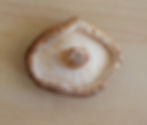Water sautéed mushrooms
- Akis
- Jul 9, 2020
- 3 min read
Cooking mushrooms is not the most daunting task in the kitchen. However, it can be somehow tricky, especially when someone is not familiar with those edible fungi, of varying shape, colour, flavour, and texture.

Let me explain by following the typical way to prepare sautéed mushrooms, that means cooking them under high heat, with a bit of oil, as to develop browning and flavours.
We normally start by chopping and throwing the mushrooms in a pan with a bit of oil. We notice suddenly the oil disappearing, the pan drying out, and the mushrooms start sticking on the pan surface. To compensate, we might add more oil but that stays also short in the pan. This goes on until mushrooms start releasing some of its abundant moisture and begin to cook properly. In the meantime, they had absorbed a lot of unnecessary oil plus they didn’t brown nicely and uniformly.

But why mushrooms absorb all this oil?
The culprits are the many, tiny air pockets that lie on the mushroom cap and stem, which can willingly suck up oil (1). Only after enough time under heat, the air pockets collapse and cannot anymore accept oil. However, at that point the mushrooms had already begun to release its abundant water, preventing thus browning reactions, which require a water-free environment to occur. In this way, we end up simply with dully cooked mushrooms.
One way to circumvent this issue and cook decent mushrooms is to use a small amount of oil but start with a very hot pan and stir constantly the mushrooms for a few minutes. This way, sticking is prevented and some browning can take place before moisture starts coming out. At least, this was the technique I was using to sauté mushrooms until now.

Recently, I came across an interesting technique for sautéed mushrooms developed by Dan Souza and his colleagues in America’s Test Kitchen. This method employs water as a medium to start cooking the mushrooms, while oil comes into play only at the end!
I tried it once, then a second time, and currently I have completely adopted it. I find it easy and neat, delivering tasty and tender mushrooms. The technique is based on the remarkable ability of mushrooms to sustain long cooking without becoming neither mushy nor tough.

The reason for this is a molecule called Chitin that is a major component of the mushroom cell walls. Chitin is a long-chain polysaccharide composed of nitrogen-containing sugar units called N-acetylglucosamine, and it is organised in a pretty heat stable meshwork that helps mushrooms to remain tender and fleshy, even after prolong cooking. It is simply, because of chitin, very difficult to over-cook mushrooms!

So, how this method works exactly?
We start by cooking the mushrooms only in some water for a few minutes. During this first cooking step, the mushrooms will reduce in size and get cooked, releasing also some of their abundant water. Additionally, because of the cooking heat, the oil-absorbing air pockets will collapse, losing their ability to absorb oil.

The cooking with occasional stirring continues until water evaporates completely and the pan becomes dry. At this point, the mushrooms are already cooked but still tender. Only now, a bit of oil comes into the pan, just to lubricate the mushrooms and help them to brown nicely after sautéing for a couple of minutes with frequent stirring.
In the end, the mushrooms are perfectly cooked and browned, without having absorbed much oil. They can be eaten as such, combined with other foods, or they can undergo further cooking to get incorporated in different sauces.
Sautéed Mushrooms

mushrooms (any kind)
water
extra-virgin olive oil
salt/pepper
- Clean mushrooms if needed with a towel and chop them as you like
- Put them in a pan with some water (just enough as to create a bed of water), bring to boil, and cook for a few minutes
- The liquid in the pan will soon turn brown, an indication that some of the mushroom’s abundant water had come out
- Continue cooking until water evaporates completely
- Add a bit of olive oil and seasoning, stir for a couple of minutes in high heat
- Serve and eat them as such, or proceed by incorporating them in a sauce
